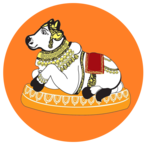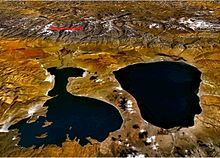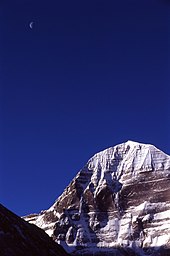Mount Kailash (also Mount Kailasa; Kangrinboqê or Gang Rinpoche (Tibetan: གངས་རིན་པོ་ཆེ; Chinese: 冈仁波齐峰 (simplified); Chinese: 岡仁波齊峰 (traditional)), is a 6,638 m (21,778 ft) high peak in the Kailash Range (Gangdisê Mountains), which forms part of Transhimalaya in the Tibet Autonomous Region of China.
The mountain is located near Lake Manasarovar and Lake Rakshastal, close to the source of some of the longest Asian rivers: the Indus, Sutlej, Brahmaputra, and Karnali also known as Ghaghara (a tributary of the Ganges) in India. Mount Kailash is considered to be sacred in four religions: Hinduism, Buddhism, Bön and Jainism.
The mountain is located near Lake Manasarovar and Lake Rakshastal, close to the source of some of the longest Asian rivers: the Indus, Sutlej, Brahmaputra, and Karnali also known as Ghaghara (a tributary of the Ganges) in India. Mount Kailash is considered to be sacred in four religions: Hinduism, Buddhism, Bön and Jainism.
| Mount Kailash | ||||||||||||||
|---|---|---|---|---|---|---|---|---|---|---|---|---|---|---|
| Gang Rinpoche | ||||||||||||||

The north face of Mount Kailash
|
||||||||||||||
| Highest point | ||||||||||||||
| Elevation | 6,638 m (21,778 ft) | |||||||||||||
| Prominence | 1,319 m (4,327 ft) | |||||||||||||
| Coordinates | 31°4′0″N 81°18′45″ECoordinates: 31°4′0″N 81°18′45″E | |||||||||||||
| Geography | ||||||||||||||
|
|
||||||||||||||
| Parent range | Transhimalaya EtymologyThe mountain is known as “Kailāsa” (कैलास) in Sanskrit.[1][2] The name also could have been derived from the word “kelāsa” (केलास), which means "crystal".[3]In his Tibetan-English dictionary, Chandra (1902: p. 32) identifies the entry for 'kai la sha' (Wylie: kai la sha) which is a loan word from Sanskrit 'kailāsa' (Devanagari: कैलाश).[4] The Tibetan name for the mountain is Gangs Rin-po-che (Tibetan: གངས་རིན་པོ་ཆེ་; Chinese: 冈仁波齐峰). Gangs or Kang is the Tibetan word for snow peak analogous to alp or hima; rinpoche is an honorific meaning "precious one" so the combined term can be translated "precious jewel of snows". "Tibetan Buddhists call it Kangri Rinpoche; 'Precious Snow Mountain'. Bon texts have many names: Water's Flower, Mountain of Sea Water, Nine Stacked Swastika Mountain. For Hindus, it is the home of the mountain god Shiva and a symbol of his power-symbol “Om”; for Jains it is where their first Tirthankara Rishabhanatha was enlightened; for Buddhists, the navel of the universe; and for adherents of Bon, the abode of the sky goddess Sipaimen."Another local name for the mountain is Tisé mountain, which derives from ti tse in the Zhang-Zhung language, meaning "water peak" or "river peak", connoting the mountain's status as the source of the mythical Lion, Horse, Peacock and Elephant Rivers, and in fact the Indus, Yarlung Tsangpo/Dihang/Brahmaputra, Karnali and Sutlej all begin in the Kailash-Lake Manasarovara region. In Hinduism
An illustration of the Hindu significance of Mount Kailash, depicting
the holy family of Shiva, consisting of Shiva, Parvati, Ganesha and
Kartikeya (Muruga)
According to Charles Allen, one description in the Vishnu Purana of the mountain states that its four faces are made of crystal, ruby, gold, and lapis lazuli.[7] It is a pillar of the world and is located at the heart of six mountain ranges symbolizing a lotus.[7] In Jainism
Rishabhadeva who is said to have attained nirvana near Mount Kailash
PilgrimageEvery year, thousands make a pilgrimage to Kailash, following a tradition going back thousands of years. Pilgrims of several religions believe that circumambulating Mount Kailash on foot is a holy ritual that will bring good fortune. The peregrination is made in a clockwise direction by Hindus and Buddhists while Jains and Bönpos circumambulate the mountain in a counterclockwise direction. [15]The path around Mount Kailash is 52 km (32 mi) long. Some pilgrims believe that the entire walk around Kailash should be made in a single day, which is not considered an easy task. A person in good shape walking fast would take perhaps 15 hours to complete the entire trek. Some of the devout do accomplish this feat, little daunted by the uneven terrain, altitude sickness and harsh conditions faced in the process. Indeed, other pilgrims venture a much more demanding regimen, performing body-length prostrations over the entire length of the circumambulation: The pilgrim bends down, kneels, prostrates full-length, makes a mark with his fingers, rises to his knees, prays, and then crawls forward on hands and knees to the mark made by his/her fingers before repeating the process. It requires at least four weeks of physical endurance to perform the circumambulation while following this regimen. The mountain is located in a particularly remote and inhospitable area of the Tibetan Himalayas. A few modern amenities, such as benches, resting places and refreshment kiosks, exist to aid the pilgrims in their devotions. According to all religions that revere the mountain, setting foot on its slopes is a dire sin. It is a popular belief that the stairways on Mount Kailash lead to heaven.
Stupas, with the north face of Mount Kailash (background)
Walking around the mountain—a part of its official park—has to be done on foot, pony or domestic yak, taking some three days of trekking starting from a height of around 15,000 ft (4,600 m) past the Tarboche (flagpole) to cross the Drölma pass 18,200 ft (5,500 m), and encamping for two nights en route. First, near the meadow of Dirapuk gompa, some 2 to 3 km (1.2 to 1.9 mi) before the pass and second, after crossing the pass and going downhill as far as possible (viewing Gauri Kund in the distance). Geology
Satellite view of Mount Kailash with lakes Rakshastal (left) and Manasarovar (right)
Mountaineering
North View of Mount Kailash
In 2001 the Chinese gave permission for a Spanish team to climb the peak, but in the face of international disapproval the Chinese decided to ban all attempts to climb the mountain.[21] Reinhold Messner, who condemned the Spanish plans, said If we conquer this mountain, then we conquer something in people's souls. I would suggest they go and climb something a little harder. Kailas is not so high and not so hard.SOURCES : KALISH MANSORAVAR YATRA A BOOK FROM GITA PRESS GOARKHPUR, AND TULSI RAMAYAN AND WIKIPEDIA | |||||||||||||









No comments:
Post a Comment